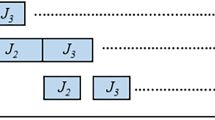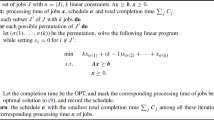Abstract
This work addresses the minimization of the makespan criterion for the flowshop problem with blocking. In this environment there are no buffers between successive machines, and therefore intermediate queues of jobs waiting in the system for their next operations are not allowed. We propose a lower bound which exploits the occurrence of blocking. A branch-and-bound algorithm that uses this lower bound is described and its efficiency is evaluated on several problems. Results of computational experiments are reported.
Similar content being viewed by others
References
Abadi, I.N.K., N.G. Hall, and C. Sriskandarajah. (2000). “Minimizing Cycle Time in a Blocking Flowshop.” Operations Research 48, 177–180.
Caraffa, V., S. Ianes, T.P. Bagchi, and C. Sriskandarajah. (2001). “Minimizing Makespan in a Flowshop Using Genetic Algorithms.” International Journal of Production Economics 70, 101–115.
Berkley, B.J. (1993). “Effect of buffer capacity and sequencing rules on single-card kanban system performance.” International Journal of Production Research 31, 2875–2893.
Dutta, S.K. and A.A. Cunningham. (1975). “Sequencing Two-Machine Flow-Shops with Finite Intermediate Storage.” Management Science 21, 989–996.
Gilmore, P.C. and R.E. Gomory. (1964). “Sequencing a One State Variable Machine: A Solvable Case of the Traveling Salesman Problem.” Operations Research 12, 655–665.
Grabowski, J. and J. Pempera. (2000). “Sequencing of Jobs in Some Production System.” European Journal of Operational Research125, 535–550.
Hall N.G. and C. Sriskandarajah. (1996). “A Survey of Machine Scheduling Problems with Blocking and No-wait in Process.” Operations Research 44, 510–525.
Leisten, R. (1990). “Flowshop Sequencing Problems with Limited Buffer Storage”. International Journal of Prodution Research28, 2085–2100.
Levner, E.M. (1969). “Optimal Planning of Parts Machining on a Number of Machines.” Automation and Remote Control 12, 1972–1978.
McCormick, S.T., M.L. Pinedo, S. Shenker, and B. Wolf. (1989). “Sequencing in an Assembly Line with Blocking to Minimize Cycle Time.” Operations Research 37, 925–936.
Nawaz, M., E.E. Enscore, and I. Ham. (1983). “A Heuristic Algorithm for the m-Machine, n-Job Flow-shop Sequencing Problem.” OMEGA 11, 91–95.
Norman, B.A. (1999). “Scheduling Flowshops with Finite Buffers and Sequence-dependent Setup Times.” Computers & Industrial Engineering 36, 163–177.
Nowicki, E. (1999). “The Permutation Flow Shop with Buffers: A Tabu Search Approach.” European Journal of Operational Research 116, 205–219.
Papadimitriou, C.H. and P.C. Kanellakis. (1980). “Flowshop Scheduling with Limited Temporary Storage.” Journal of the Association for Computing Machinery 27, 533–549.
Pinedo, M. (1995). Scheduling: Theory, Algorithms, and Systems. New Jersey: Prentice-Hall.
Reddi, S.S. (1976). Management Science 23, 216–217.
Reddi, S.S. and C.V. Ramamoorthy. (1972). “Flowshop Sequencing Problem with No Wait in Process.” Operational Research Quarterly 23, 323–330.
Reklaitis, G.V. (1982). “Review of Scheduling of Process Operations.” AIChE Symposium Series 78, 119–133.
Ronconi, D.P. (2004). “A Note on Constructive Heuristics for the Flowshop Problen with Blocking.” International Journal of Production Economics 87, 39–48.
Ronconi, D.P. and V.A. Armentano. (2001). “Lower Bounding Schemes for Flowshops with Blocking In-Process.” Journal of the Operational Research Society 52, 1289–1297.
Sharadapriyadarshini, B. and C. Rajendran. (1996). “Formulations and Heuristics for Scheduling in Buffer-constrained Flowshop and Flowline-based Manufacturing Cell with Different Buffer-space Requirements for Jobs: Part 1.” International Journal of Production Research 34, 3465–3485.
Suhami, I. and R.S.H. Mah. (1981). “An Implicit Enumeration Scheme for the Flowshop Problem with No Intermediate Storage.” Computers and Chemical Engineering 5, 83–91.
Taillard, E. (1993). “Benchmarks for Basic Scheduling Problems.” European Journal of Operational Research 64, 278–285.
Author information
Authors and Affiliations
Corresponding author
Rights and permissions
About this article
Cite this article
Ronconi, D.P. A Branch-and-Bound Algorithm to Minimize the Makespan in a Flowshop with Blocking. Ann Oper Res 138, 53–65 (2005). https://doi.org/10.1007/s10479-005-2444-3
Issue Date:
DOI: https://doi.org/10.1007/s10479-005-2444-3




